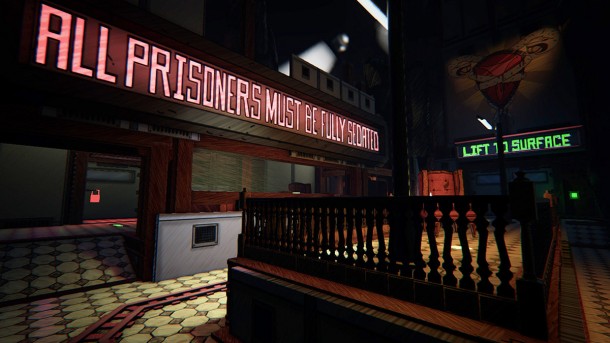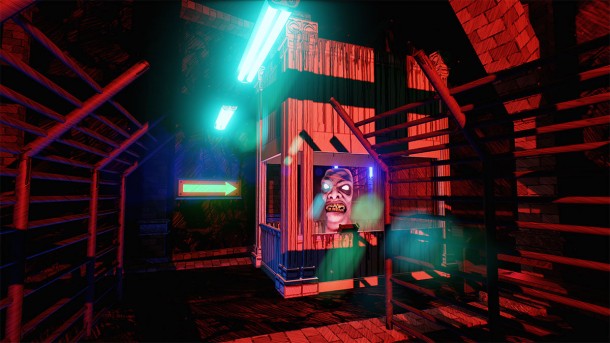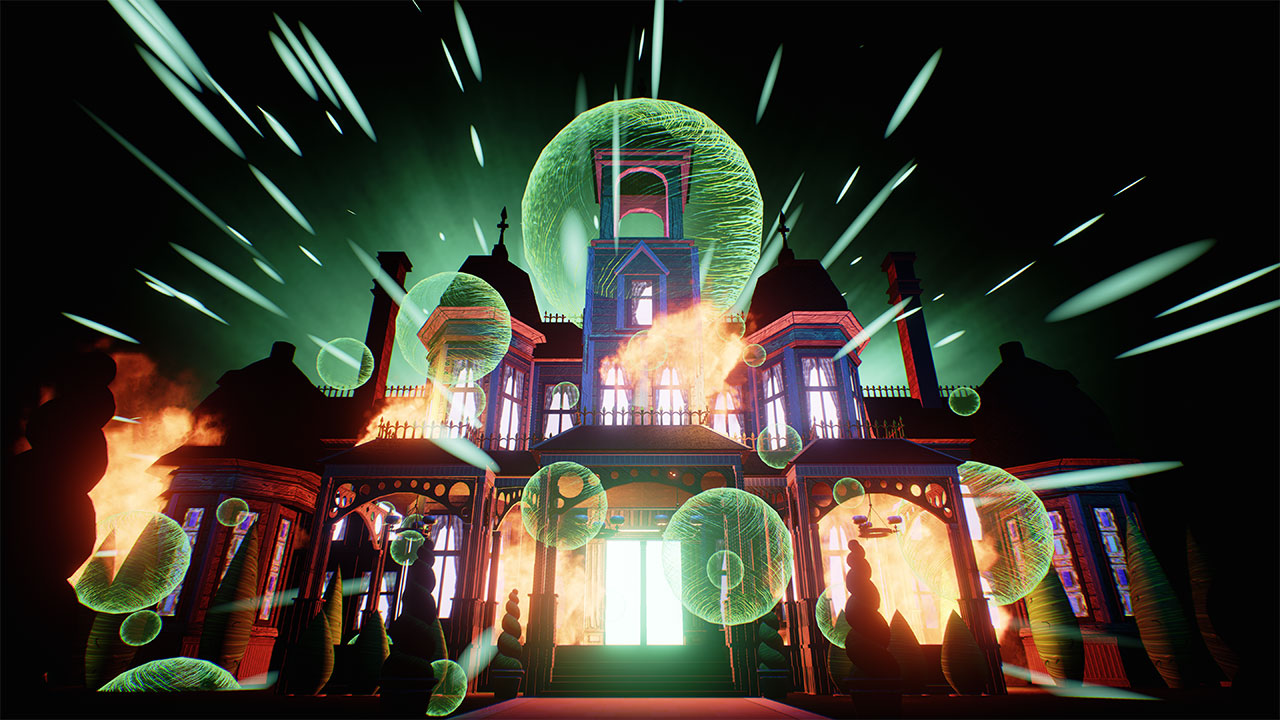Albino Lullaby’s most memorable set-pieces feature whirling-twirling architecture—a neon-splattered series of rooms that can be rotated with the push of the button. These environments feel like a nonsensical carnival funhouse, all clad in bright colors and flaunting a paradoxical layout straight out of Kubrick’s The Shining. Such areas also serve as a handy metaphor for the game itself. Every push of the button risks revealing too many of the mechanisms powering the device, and while this transparency often exposes some flaws, it also provides meaningful glimpses into Albino Lullaby’s glaring potential.
In a horror genre strewn with jump-scares and gore, Ape Law promises a different kind of experience with their inaugural effort —one that they describe as a “psychological nightmare.” To this extent, Albino Lullaby is extremely successful. It’s very much a cerebral horror: the game unsettled me by way of its weirdness, often prompting laughter that was equal parts nervousness and delight. The monsters may disturb other players, but I was primarily amused by them and their over-the-top voice acting.

The episode begins with the player-character escaping their cell and striving to find a means of escape. While the shifting rooms provide a soft puzzle element to the gameplay, the rest is standard button-pressing, key-finding fare. Notes scattered throughout the environment flesh out an otherwise absent narrative, allowing players to connect the dots and construct their own grisly interpretations. These notes are made more mysterious by the monsters’ distinct lack of appendages, which begs the question of how these notes came to be in the first place.
The arrival of the Grandchildren—the game’s fleshy, foul-faced monsters and presumed note-writers—marks one of the most chilling and comedic moments in Albino Lullaby. Like Amnesia and a few other games, there (initially) is no means of fighting back against the Grandchildren, and so clumsily sneaking past these strange characters becomes the priority. I emphasize “clumsy,” here, since it was difficult to identify what alerted the Grandchildren. On some occasions, I was able to walk right in front of them; at other points, they saw me even though I was crouched behind a column and far away from them.
Once a Grandchild sees you, they will not stop following you. Or, more accurately, ALL of the Grandchildren won’t stop following you. Though the first instance of rounding a corner and seeing a horde of Grandchildren is terrifying, this mechanic can quickly become more of a frustration than a fright. Only blue lights or checkpoints can stop the ghoulish fiends, so players must pass a check-point or area barrier to shake off their pursuers. On one occasion, I found myself stranded in the middle of a bridge, safe on account of the blue lanterns to either side of me, but also perpetually in peril due to the aggrieved Grandchildren beyond the blue aura. I was able to squeeze past my pursuers and finish my task (which, you guessed it, involved pushing more buttons). That was the tipping point where the Grandchildren became more of an annoyance than a noteworthy enemy. Most often, being spotted effectively bars players from progressing until they let the Grandchildren catch them.

This pursuit mechanic is worsened by the obfuscated level-design. At times, the game directs players too enthusiastically with bright arrows and large signs reading “Leave Key Here” (though, to be fair, that latter moment is funny). At other points, the direction is obscure at best, often requiring players to leap out a nondescript window and take an equally vague path through rooftops. Upon replaying the game, I finally noticed a few illuminated areas that were supposed to indicate the correct path, but there are other illuminated areas that tempted me into an early death. The game’s objective mechanic failed to alleviate my confusion. The objectives are sometimes helpful, but they are often absent or intentionally vague when they are needed most. In point of fact, one objective toward the episode’s climax simply reads “I dunno, wtf.”
While Albino Lullaby’s gameplay and narrative can use some polish, its atmosphere is its best feature. Rather than working with a bland, gray-washed palette, Ape Law takes their aesthetic in the opposite direction. Bright, saturated hues dominate both the lower chambers and the luxe mansion above. Even when the game plunges players into the depths of the earth, these bright colors serve as a counterpoint to the gloom (and often act as a light to guide their way). The hand-drawn textures also contribute to the game’s appearance, resulting in an appearance that’s both cartoonish and garish. Acme-esque signs, which tease players with promises of a “Lift to the Surface” or ask “Are you Sure?” above tempting buttons, act as additional zany flourishes. It looks like a setting from Courage the Cowardly Dog, though even that comparison doesn’t quite do it justice. The atmosphere consistently hits all the right notes, and it’s further improved by a pretty spectacular soundtrack.
There’s a lot of room for improvement with Albino Lullaby. There’s also a lot of potential. Even though the game too often revealed the creaky, grinding mechanisms beneath its surface, I was nevertheless riveted. I adored the atmosphere and even the ghoulish Grandchildren, and I was perfectly content to press through the episode’s more frustrating moments in good faith that what awaited was marvelously and memorably weird. In short, Albino Lullaby is the videogame equivalent of a travelling carnival. It is bright, kooky, and dizzyingly colorful in its presentation, and it offers a wealth of comedic and chilling moments in turn.
Just don’t look too closely at the ride itself, or you’re bound to notice more than a few loose screws.
This review is based off of a Steam Code provided to SideQuesting by the publisher.



No Comments